Prato
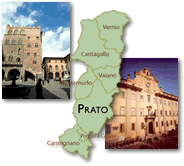
Emanuele Repetti defined Prato as a "noble, industrious and beautiful city", perfectly grasping its many aspects. A thriving Ghibelline commune as of the 13th century, it then passed into the orbit of Florence, becoming one of the most important economic centres of the Grand Duchy. The centuries-old tradition of working fabrics developed, already as of the early 18th century, into an industrial production, which is still vital today.
[Given the limitations on traffic in the historical centre, we advise you undertake the proposed itinerary on foot]
Tracing back the history of working fabrics and wool means tracing the history of Prato itself. This is why a visit to the Museo del Tessuto constitutes an ineluctable introduction for the visitor.
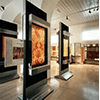
The manufacturing industry of Prato boasts a tradition that sinks its roots in the early 12th century, the period from which we have the first news of the presence of plants for wool manufacture. The economic prosperity of textiles ended in the 15th century. Following a standstill owing to the sack of Prato in 1512, and to the rigid restrictions of the Wool Merchants Guild, manufacture was relaunched thanks to the efficient legislative measures introduced by the Lorraines. In the early 19th century, the textile machines made in the workshop of Giovan Battista Mazzoni introduced the most advanced technologies for the epoch, putting the Prato industry in step with the greatest European productions. The same period saw the institution, in Prato, of a school of elementary mathematics applied to the arts, Ťa very important school for this manufacturing city [that] - as Repetti recalls in his Dizionario geografico fisico storico della Toscana - can be considered the Manchester of the Grand Duchy and the manufacturing emporium of Tuscanyť.
The great manufacturing tradition of Prato is today documented by the Textile Museum, unique in Italy for its wealth of materials. Founded in 1975 following the donation of more than 600 pieces by businessman and collector Loriano Bertini from Prato, the collections were then enlarged thanks to public and private contributions. In May 2003, the Museum was transferred to its new venue in the former Cimatoria Campolmi, a nineteenth-century textile factory that remained in operation until 1990 circa, purchased and restored by the Communal Administration of Prato.
The Museum, which occupies a wing of the ex industrial complex, has received a completely new layout, proposing a new and more articulate exhibition itinerary. The historical collection comprises antique fabrics (about 5000 exhibits), from the 3rd century to the 19th century, from various geographical areas, both European and extra European. The contemporary collection (about 3000 exhibits) presents fabrics and collections of samples of the Prato textile industry, ranging from the late 19th century till today. Finally, the collection of weaving tools (about 100 exhibits from the 18th to the 20th century) also includes several instruments for hand-weaving, such as spinning wheels, cone-winding frames and trestles for scotching hemp. The collection is also enriched by dynamometers, hat-blocks for fezzes, and a tearing machine from 1850 to recover textile fibre from rags.
The Museum Library conserves valuable and rare editions, in addition to anastatic reprints. The Prato institution conducts an intense educational and research activity, availing itself of a learning workshop which addresses schools of every kind and grade, and formative activities for adults.
The institution’s management is entrusted to the Textile Museum Foundation whose founding members are the Commune and Province of Prato, the Industrial Union of Prato, the Chamber of Commerce, Industry and Handicrafts of Prato, and Cariprato.
(Graziano Magrini)
A brief walk along Via Pallacorda and Viale Piave leads to the Emperor’s Castle, a grandiose, unique example of the military architecture of Frederick II in Central Italy.
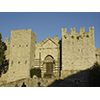
Also known as Fortress of Saint Barbara or Swabian Castle, the Emperor’s Castle was built by order of Frederick II of Swabia around the mid 13th century, and is a unique example of its kind in central-northern Italy. The building’s rigorous geometric plan and the construction technique using carefully squared blocks of alberese (a type of limestone), recall examples of Swabian military architecture in Southern Italy. This is confirmed by sources which recall that the Sicilian architect Riccardo da Lentini had the workers needed to build the castle summoned from Puglia. Conceived as the seat of the Imperial Vicar in Tuscany, the interior of the castle was never completed. Several capitals sculpted on the internal face of the walls are the only evidence of the buildings which were supposed to be erected in the square courtyard of the complex. Worthy of note is the careful placement of embrasures, conceived to assure archers and crossbowmen the possibility of front and side shots. The only concession to local architectural traditions is the entrance, marked by the green and white marble, typical of the Tuscan Romanesque style.
(Elena Fani)
Travelling along Via Cairoli, you soon reach the old centre of political life of the city, Piazza del Comune. The square is dominated by the fourteenth-century Palazzo Pretorio, venue of the Museo Civico of Prato, the scientific interest of which mainly consists in the collections from the pharmacies of the medieval hospitals of Prato.
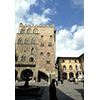
The Civic Museum, which has been located since 1912 in the medieval Palazzo Pretorio, constitutes the city's oldest cultural institution for history and collections. Promoted by Grand Duke Peter Leopold of Lorraine as early as 1788, with the intention of creating a "school of taste" for future artists, it was inaugurated in 1858 in the nearby Palazzo Comunale.
The Museum displays a number of masterpieces from the 14th century, Renaissance paintings, seventeenth-eighteenth century works, nineteenth-century drawings, Della Robbia sculptural works, sculptures by the Prato artist Lorenzo Bartolini and objects from the production of the minor arts (eighteenth-century ceramics, weapons from the Risorgimento period, Gonfaloniers' costumes).
Although the Museum has a predominantly historical artistic orientation, it is also quite interesting from the historical scientific viewpoint, due to the presence of the collection coming from the pharmacy of the Misericordia e Dolce Hospital.
According to some historians, among them Pedrazzini and Fracassini, the pharmacy must have been in existence already in the 13th century. In 1545 it was re-established as a pharmaceutical laboratory. After having ceased to operate toward the end of the 19th century, it was rebuilt in 1933 in a fourteenth-century hall in Prato's Palazzo Pretorio, at the initiative of the pharmacist Tommaso Fracassini. The furnishings consist of a wooden cabinet painted light blue, decorated with lozenge motifs and trimmed in white. The pharmaceutical collection is composed of numerous decorated majolica jars of various shapes, some of them produced by the Ginori Manufactory of Doccia in the 18th century. The jars are labelled with the names of the most commonly used medicinals. The collection also includes four wooden painted boxes labelled with the names of pharmaceuticals, and twelve glass recipients.
The Museum is temporarily closed for restoration, but the most important objects in the collection have been moved to the Cloister of San Domenico (site of the Wall Painting Museum).
(Graziano Magrini)
From Piazza del Comune, crossing Via del Porcellatico, we reach Via Ser Lapo Mazzei, where stands Palazzo Datini, undoubtedly one of the most interesting examples of fourteenth-century civil residence in Tuscany. Today, the building houses the Archivio di Stato which englobes the very important Datini archive, a precious token of the commercial activity of Prato between the 14th and 15th centuries
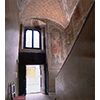
The Prato State Archives Section, instituted in 1957, occupies premises on the first floor of Palazzo Datini, a residence purchased and entirely remodelled in the last decades of the 14th century by Francesco di Marco Datini. It contains the remarkably rich "Datini Archives", now also fully digitized and available on-line, with the business and private correspondence of the famous Prato merchant and banker from 1382 to 1410. Some of the letters have samples of woollen cloth attached to them. Particularly interesting are the Municipal Historical Archives and those of the Prato Misericordia e Dolce Hospital. The notarial records, those of the religious corporations and the Diplomatic Archive are kept in the State Archive of Florence.
Other interesting documents are those pertinent to the Accademia degli Infecondi, literally the Unfruitful ones, founded around 1712 as a theatrical and literary academy. In the early years of the 19th century the academy assumed a new orientation, attempting to conjoin science and literature, and continued in this direction until its activity came to an end in 1841. Accordingly, it engaged in discussions on Italian history and literature, but also on hydraulics, vaccination, the popular teaching of geometry and of mechanics applied to the arts and trades, as well as the industry and economy of Prato.
(Graziano Magrini)
Finally, going straight down Via Tinaia, we reach Piazza del Collegio, dominated by the building that houses the Convitto Nazionale Francesco Cicognini, whose alumni include illustrious figures such as Gabriele D’Annunzio.
Founded as a Jesuit boarding school in 1692, it began its teaching activity on the premises it still occupies today, inaugurated in 1715, under the direction of the grand-ducal architect Giovanni Battista Foggini. From 1773 to 1862, due to the suppression of the Society of Jesus decreed by Pope Clement XIV, the school was managed by secular priests, under the name of Imperial and Royal Boarding School. Between 1799 and 1812, during the French occupation, initiatives were undertaken to reform the institution. In 1859, subsequent to the Plebiscite that deposed Grand Duke Leopold II from sovereignty over Tuscany, the school became State property under the name of Reale Collegio Convitto [Royal Boarding School College], and was included in the national educational system. A Royal Decree of 1882 instituted the Regio Convitto Nazionale [Royal National Boarding School]. In 1950 it assumed its present name, in honour of the Canon Francesco Cicognini, thanks to whose legacy it had been instituted.
On the facade of the school is a circular glass quadrant with 12 Roman numerals in iron standing out in relief. Although the turret with the bells and the quadrant on the facade date from 1740, the present clockworks date from the first half of the 20th century, as stated on the plate on the horizontal frame: "Installed by the Icaro Gironi company – January 1932".
The School possesses a collection of about seventy instruments and educational models for the teaching of Physics and the Natural Sciences, most of them dating from the middle of the 20th century. Kept in the laboratories of physics and natural science, many of the instruments are still used today for teaching purposes. The historic scientific collection that belonged to the Boarding School is now found at the Liceo Classico "Cicognini" ["Cicognini" Classical Secondary School] in Prato.
(Carlo Triarico)
****************************
Texts by Elena Fani
English translation by Victor Beard
Last update 09/ott/2008



 = libraries and archives
= libraries and archives  = scientific research centers
= scientific research centers  = memorial places of scientists
= memorial places of scientists = public health places
= public health places = places of science and worship
= places of science and worship = places of technology
= places of technology  = museums and collections
= museums and collections  = villas and gardens of science
= villas and gardens of science


